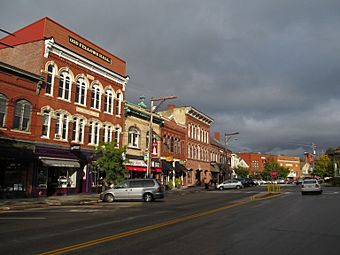Exeter Waterfront Commercial Historic District facts for kids
|
Exeter Waterfront Commercial Historic District
|
|
 |
|
| Lua error in Module:Location_map at line 420: attempt to index field 'wikibase' (a nil value). | |
| Location | Chestnut Hill Ave., Water, Franklin, Pleasant, High and Chestnut Sts., Exeter, New Hampshire |
|---|---|
| Area | 28 acres (11 ha) (original size) 35 acres (14 ha) (after boundary increase) |
| Architectural style | Greek Revival, Late Victorian, Federal |
| NRHP reference No. | 80000299 (original) 86003516 (increase) |
Quick facts for kids Significant dates |
|
| Added to NRHP | December 3, 1980 |
| Boundary increase | December 29, 1986 |
The Exeter Waterfront Commercial Historic District is a special area in Exeter, New Hampshire. It includes many old shops and homes along the waterfront. This district stretches along Water Street and parts of High and Chestnut streets. It's a very important place because it's where Exeter first began in 1638. The area quickly became a busy center for building ships. This historic district was added to the National Register of Historic Places in 1980. It was made larger in 1986 to include the Exeter Manufacturing Company's old mill buildings.
Contents
Exploring Exeter's Historic Waterfront
The Exeter Waterfront Commercial Historic District shows us how the town has grown over hundreds of years. It has buildings from different time periods, like the 1700s and the 1800s. Walking through this area is like taking a trip back in time!
How Exeter Began
Exeter was started in 1638 by a man named Rev. John Wheelwright. He and his followers moved here after having disagreements about religion in the Massachusetts Bay Colony. They chose this spot because it was right on the Squamscott River. This river was perfect for travel and trade.
Busy River, Busy Town
Because of its river location, Exeter quickly became a hub for building ships. It was also a major place for shipping lumber. The main part of the town grew on the south side of the river. Homes for people lived on the north side. The river was like a highway for goods and materials.
Buildings with a Story
Many old buildings in the district tell stories of Exeter's past.
The Gilman Garrison House
One of the oldest buildings still standing is the Gilman Garrison House. It was built around 1700. This house is special because it's one of the few "sawn-log garrison houses" that still exist. A garrison house was built strong, almost like a fort, to protect people. Today, it's a museum run by Historic New England. You can visit it to learn about life long ago.
Mills and More
In 1827, a large mill complex was built right on the river. This mill created many jobs. Because of the mill, new homes were built nearby for the workers, especially in the Pleasant Street area. Another old industrial building is the Gilman grist mill. It's located on Kimball Island in the river. A grist mill was used to grind grain into flour.
Exeter's Changing Look
Exeter faced some big fires in the mid-1800s. After these fires, many new buildings were constructed using brick. This is why a large part of Water Street today has brick buildings. These buildings give the downtown area its current look. However, some parts of Water and High streets still have older buildings. These are mostly wood-frame homes and shops from the early 1800s. They show us what the town looked like before the fires.

